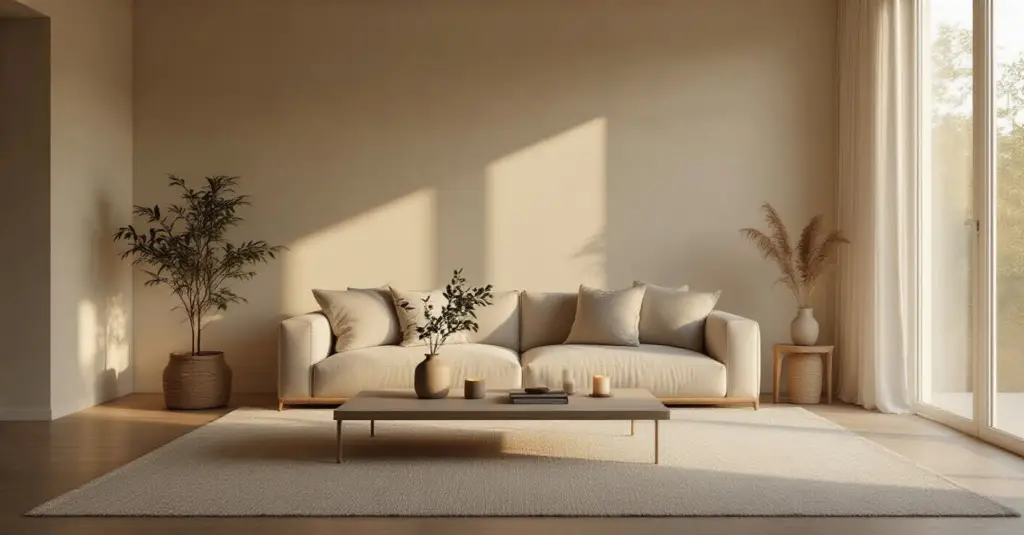Can we please talk about why everyone gets minimalist living rooms wrong? People hear “minimalist” and they picture a sad, empty white box with one uncomfortable chair and maybe a single, lonely plant. It looks cold, sterile, and about as welcoming as a dentist’s office. That’s not minimalism; that’s just a room with no soul. And it’s the absolute last thing you want when you’re trying to create a space where people actually want to hang out, watch the game, or settle in for an epic movie marathon.
I design entertainment spaces for a living. I integrate high-end audio and video with killer interior design to build rooms that bring people together. The real secret to a great minimalist entertainment room isn’t about getting rid of stuff—it’s about getting rid of distractions. It’s about making the people, the conversation, and the incredible 4K picture on your screen the main event. It’s about creating a space so comfortable and immersive that your friends never want to leave. So, if you’re ready to create a room that’s clean, modern, and the go-to spot for every gathering, here’s how we actually do it.
Building a Minimalist Living Room: Essential Foundations
First things first. You can’t just buy a white couch and call it a day. The foundation of a truly awesome minimalist space is built on a mission. It’s about defining what you want the room to do and then ruthlessly clearing the path for that to happen. This is the part where we set the stage for epic experiences.
1. Define Your Minimalist Purpose for a Calmer Space
You know what people always ask me? “Where do I even start?” And I always tell them to forget the paint swatches and the furniture catalogs for a minute. Instead, ask yourself: “What is the primary mission of this room?” Is it for jaw-dropping movie nights with full surround sound? Is it the ultimate Sunday command center for watching six football games at once? Is it a high-fidelity listening room for your vinyl collection, or a competitive gaming arena? Be specific. “Hanging out” is not a mission. “Hosting 8 friends for a Super Bowl party with no bad seats” is a mission.
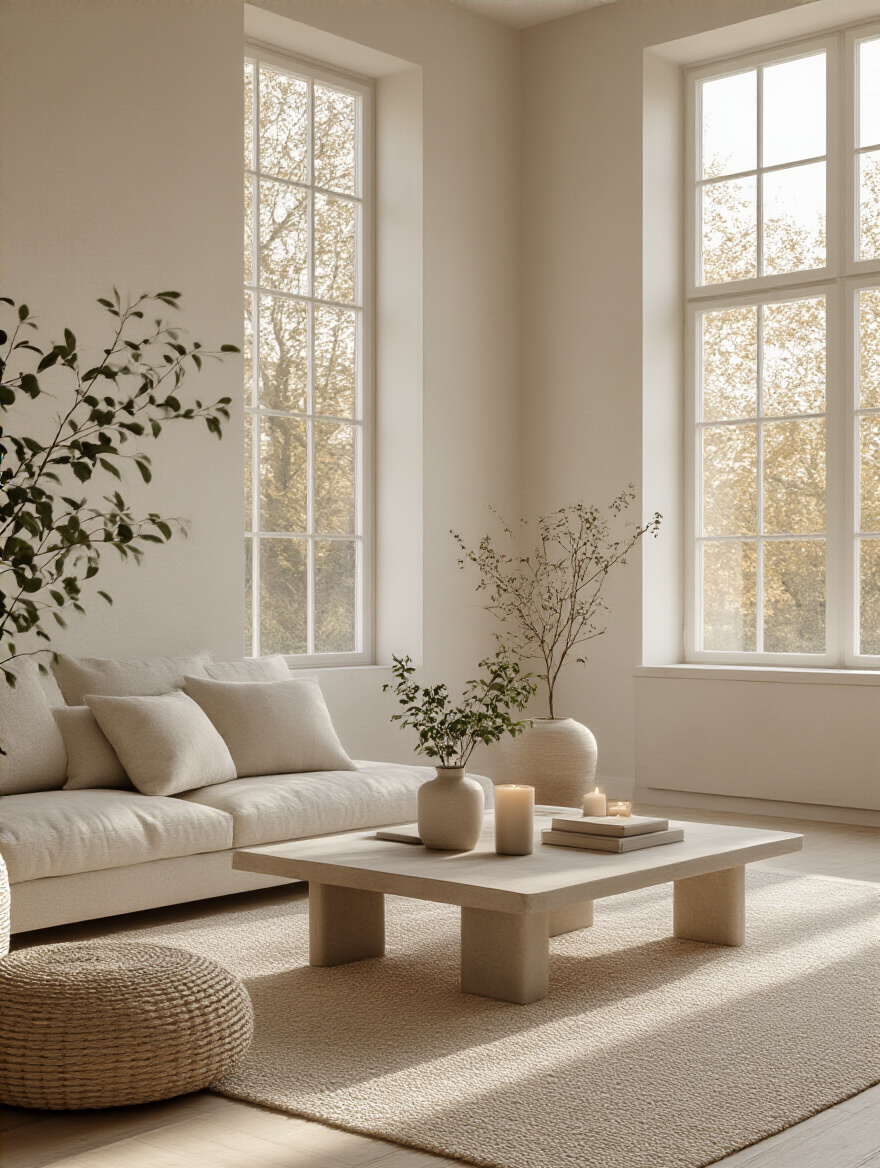
Writing down your room’s mission statement—like “This room is for immersive, distraction-free movie nights and relaxed, intimate conversations”—changes everything. Suddenly, every decision becomes simple. Does this giant, reflective glass coffee table serve the mission? No, its glare is a distraction. Does this lumpy, stylish-but-uncomfortable sofa serve the mission? No, you can’t sit on it for the entirety of The Lord of the Rings trilogy. Your mission is your filter. It cuts through the noise and keeps you focused on creating a space that actually works for how you want to live and entertain.
This initial step isn’t just fluffy design-speak; it’s a practical blueprint that saves you from expensive mistakes down the line. It’s the core of building a room that’s not just clean, but highly functional.
2. Perform a Comprehensive Declutter: Remove Non-Essential Items
Once you have your mission, the decluttering process isn’t about what to throw away; it’s about what gets to stay. Look around your living room right now. Every single object in that room is a distraction pulling focus away from your beautiful TV and expensive sound system. That pile of magazines, the tchotchkes on the shelf, the extra throw pillows—they are all visual noise competing with the main event. Your goal is to eliminate the competition.
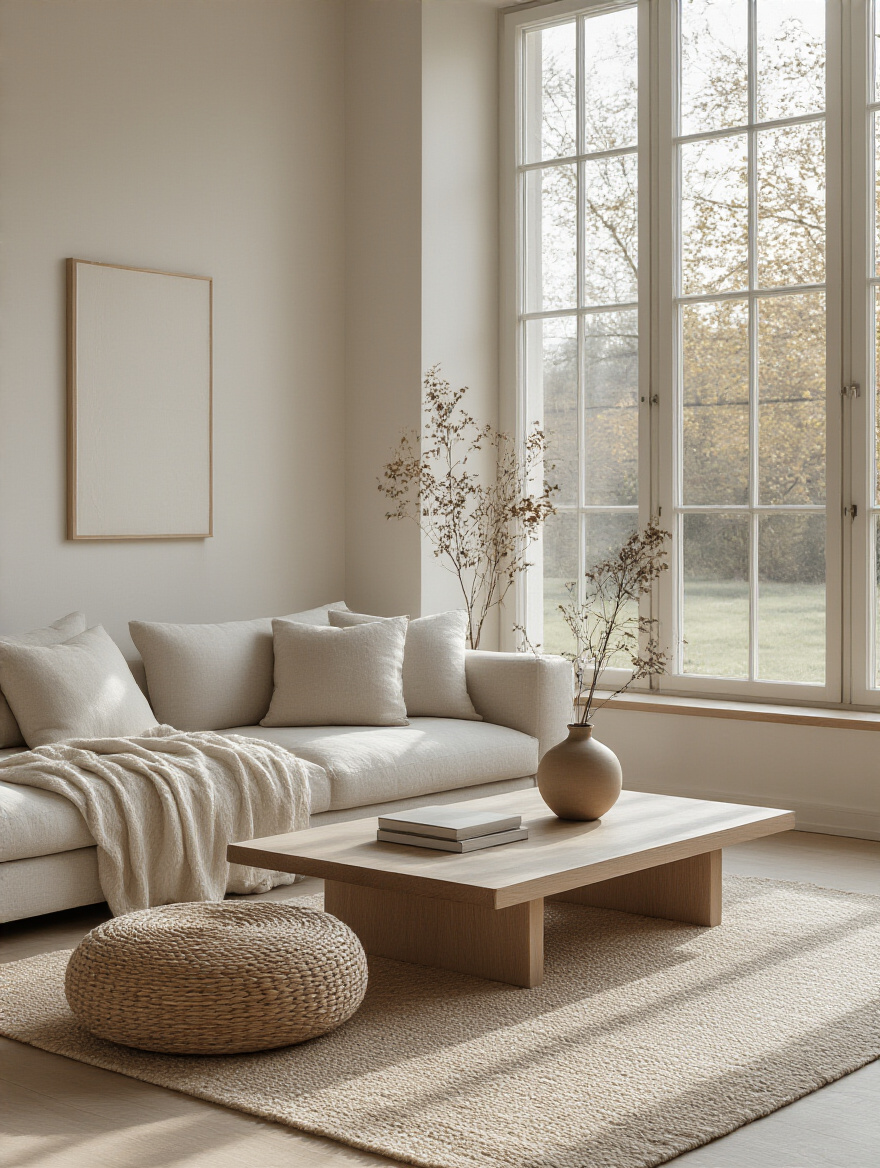
I once worked with a client who had this incredible, top-of-the-line home theater setup, but his living room was so full of stuff that it felt chaotic. We spent a weekend being ruthless. We didn’t just tidy up; we asked of every single object, “Does this make the movie-watching experience better?” The seashell collection from a vacation ten years ago? Nope. The stack of old Blu-rays when he streams everything now? Gone. By the time we were done, the room felt twice as big and the entire focus shifted to the stunning screen. Decluttering is the cheapest, most effective way to upgrade your entertainment experience.
With a clear space, your gear can finally breathe, both literally and visually. This sets the stage for a more immersive and engaging experience for everyone in the room.
3. Master the “One-In, One-Out” Rule for Clutter Control
Okay, so you’ve decluttered. Great. Now you have to defend that beautiful, clean space from future you. The “One-In, One-Out” rule is your secret weapon. For us tech lovers, this is especially critical. You just bought a new Sonos Arc soundbar? Awesome. That means the old Vizio soundbar it replaced has to leave the building. Not move to the bedroom, not go in the garage “just in case.” It’s out. Sell it, donate it, give it away.
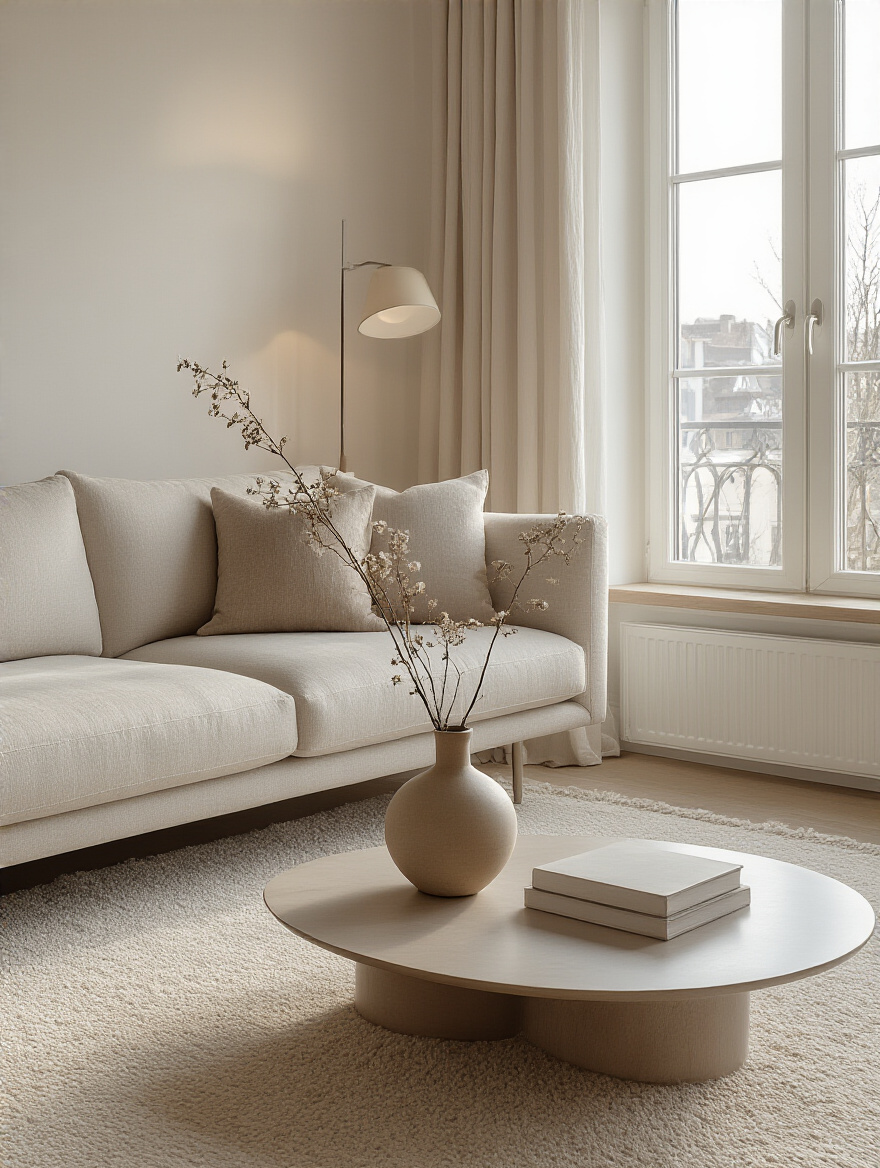
This rule stops the slow, creeping accumulation of “backup tech” and old gear that turns a sleek media center into a museum of obsolete electronics. The same goes for anything else. You get a new throw blanket? An old one goes. You buy a new controller for your PS5? The one with the sticky left trigger finally gets recycled. It forces you to be a conscious consumer and an active curator of your space. It’s not about deprivation; it’s about making a deliberate upgrade, not just an addition.
Think of it as maintaining peak performance for your room. You wouldn’t keep old, worn-out parts in a high-performance car, so don’t let outdated gear clutter your high-performance entertainment space.
4. Create a ‘Holding Zone’ for Undecided or Sentimental Items
I confess: I used to have what I called the “Drawer of Doom.” It was filled with every random cable, old remote, and unidentifiable power adapter I’d ever owned. We all have one. The holding zone is the solution. It’s a single, designated box or bin, stored out of sight, for anything you’re not sure about. That set of speakers you might fix one day? The box of old family photos you want to digitize eventually? They go in the holding zone.
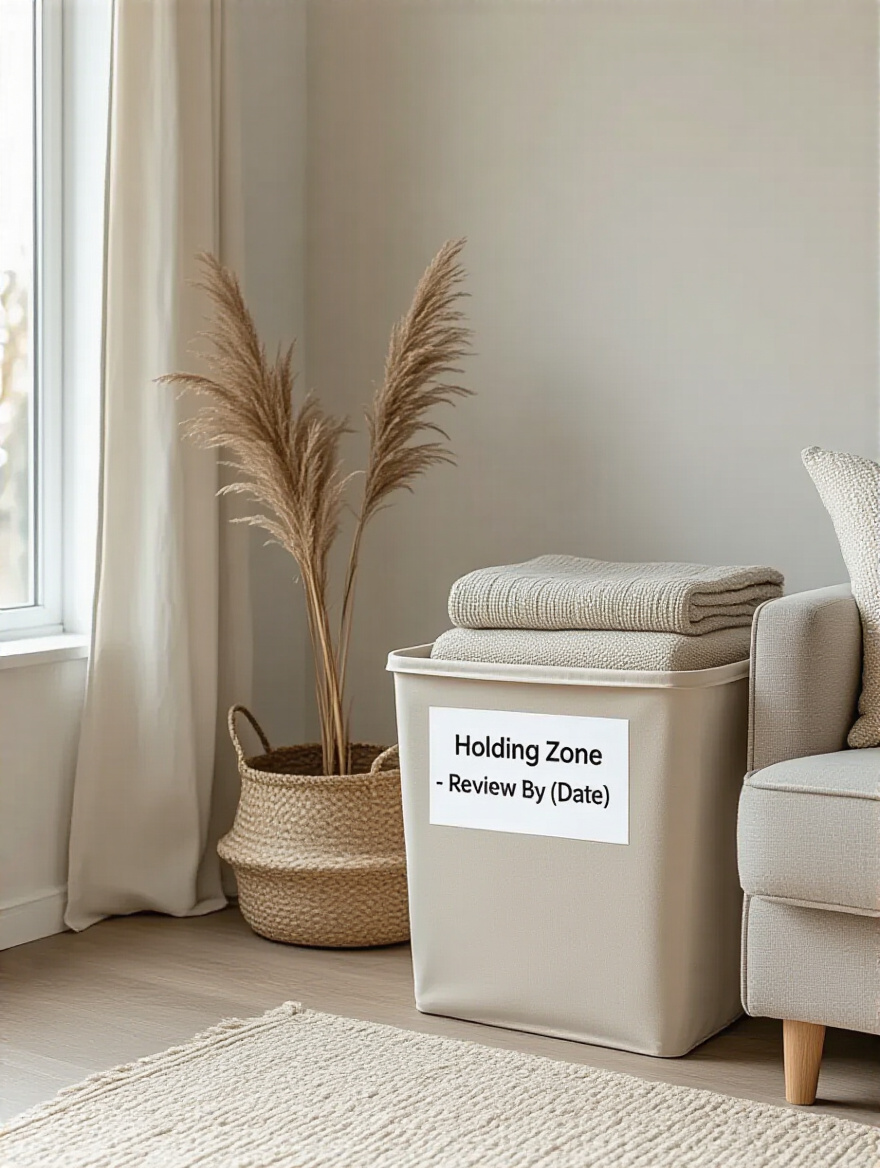
Here’s the trick: you have to put a date on the box. “Review by December 31st.” This is crucial. It’s not a permanent dumping ground; it’s a temporary stay of execution. It gets the clutter out of your main living area, immediately improving the space, while giving you permission to not make a final, emotional decision right this second. When the review date comes, you’ll have the clarity to make the call. Most of the time, you’ll find you haven’t missed the item at all, making it easy to let go.
This prevents decision fatigue and lets you keep momentum. It’s the perfect compromise between ruthless decluttering and sentimental attachment, ensuring your main space stays clean and focused.
5. Digitize Papers and Media to Drastically Reduce Physical Clutter
This one is a game-changer. Those towering shelves of DVDs, CDs, and Blu-rays? They are the enemies of minimalism. In an age of streaming and media servers, there is absolutely no reason for physical media to be occupying prime real estate in your living room. The space taken up by a single DVD tower could be used for a much better subwoofer or a more comfortable chair. It’s a no-brainer.
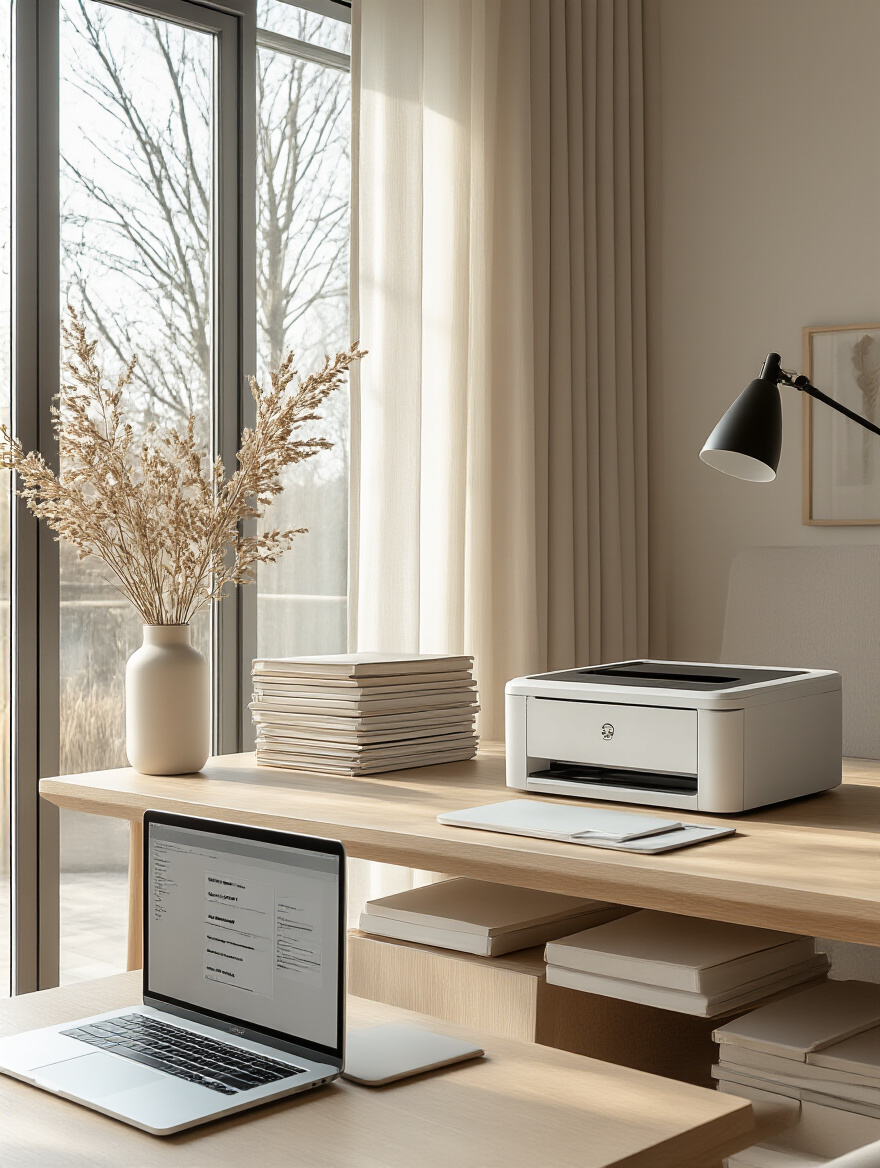
My advice: commit to a weekend project. Rip all your CDs and Blu-rays to a NAS (Network Attached Storage) drive, like a Synology or a QNAP. Set up a Plex server. It’s easier than it sounds, and the payoff is immense. You get instant access to your entire library on any device, in pristine quality, with zero physical footprint. The same goes for photos—scan them. And for paperwork, use an app like Adobe Scan to turn your phone into a high-quality document scanner. Then, shred the originals. The feeling of getting rid of all that physical bulk is unbelievably liberating.
You’re not just clearing clutter; you’re upgrading your entire media experience to be more streamlined, accessible, and ready for a modern, minimalist space.
6. Evaluate Every Item for Utility or Genuine Aesthetic Joy
This is the final filter. For every single item you’ve decided to keep, you need to hold it in your hand and ask two simple questions. First: “Does this make the entertainment experience in this room objectively better?” This is the utility test. A universal remote passes. An extra-long charging cable for the controller passes. The second question: “Does looking at this thing make me genuinely happy and enhance the room’s vibe?” This is the aesthetic joy test. That one piece of awesome art passes. The cool vintage turntable passes.
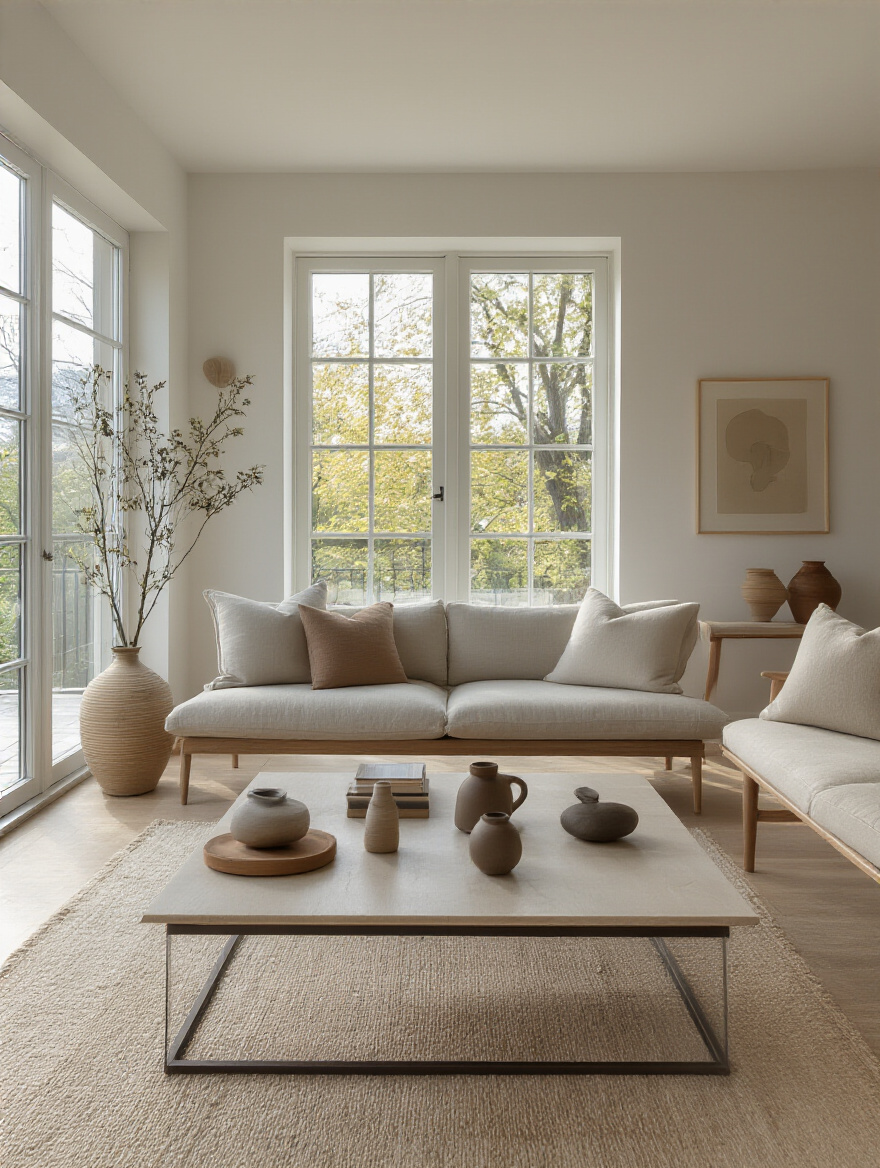
Everything else has to go. The corporate swag mug you’ve been using as a pen holder? Fails both. The weird decorative orb that just collects dust on the media console? Fails. This is where you get really honest. Most people fill their spaces with things that are just… there. They don’t serve a purpose and they aren’t particularly beautiful. In a minimalist room, every single object has to earn its spot.
This ruthless evaluation ensures your room is filled with only two types of things: high-performance tools and sources of pure joy. Everything else is just noise.
Strategic Furniture Selection & Optimized Layout
Okay, the room is clean and the mission is clear. Now we build the command center. Furniture in a minimalist entertainment space isn’t just for sitting—it’s a strategic tool for shaping the experience. It directs flow, enhances comfort, and supports the technology.
7. Choose Multi-Functional Furniture for Maximum Space Efficiency
Multi-functional furniture is the James Bond of interior design—it’s sleek, smart, and has a few tricks up its sleeve. We’re not just talking about a sofa bed. Think bigger. An ottoman with hidden storage is non-negotiable; it’s where you stash the controllers, headsets, remotes, and extra cables. Instantly, your coffee table is clean. A lift-top coffee table can transform from a footrest into a perfect-height surface for snacks and drinks during the game.
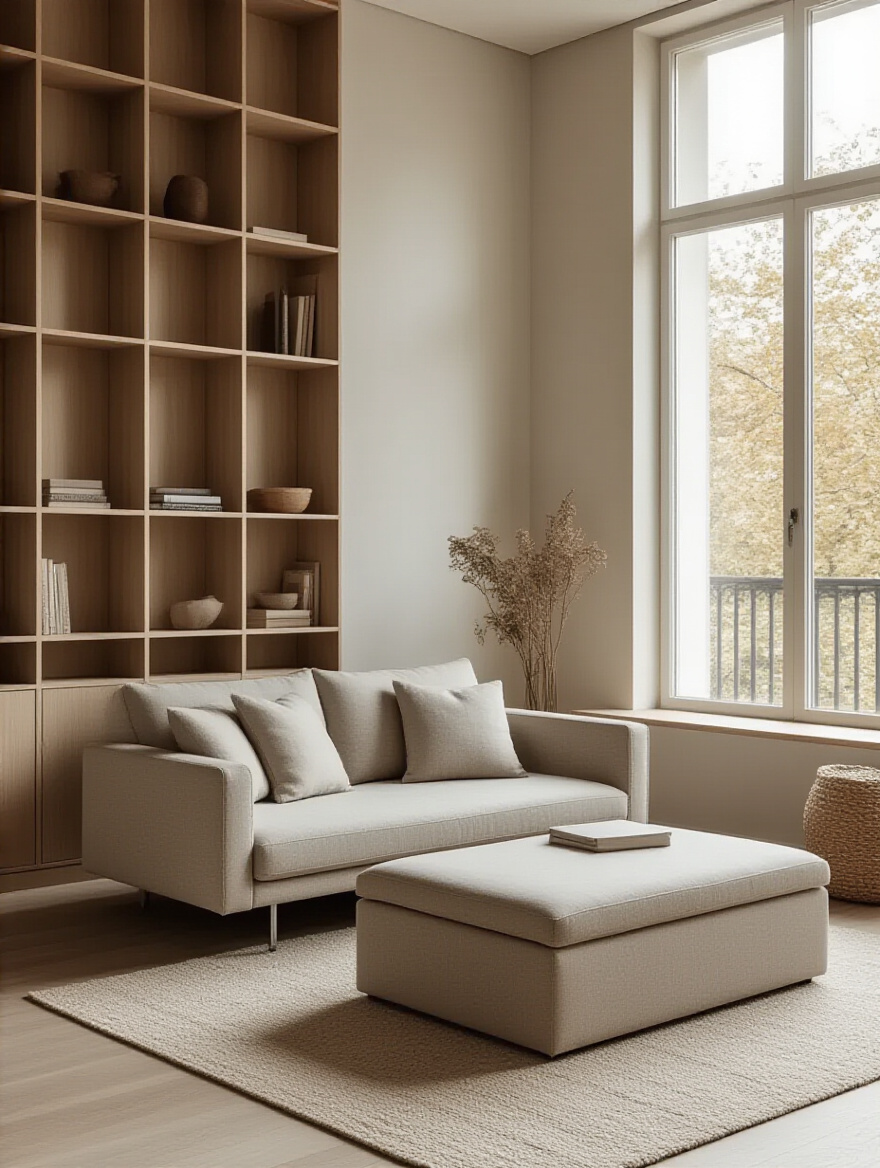
I’m a huge fan of modular sofas. For a movie night, you can push them together into one giant, cozy lounge pit. For a party, you can break them apart into smaller conversation zones. The goal is furniture that adapts to the event. A beautiful credenza doesn’t just hold up the TV; it has perforated or fabric-covered doors that let IR signals pass through and heat escape, keeping your gear hidden and cool.
This isn’t just about saving space; it’s about creating a flexible environment that can transform to meet the demands of any social gathering.
8. Invest in Quality, Durable Pieces That Stand the Test of Time
Here’s a hard truth: that cheap, flat-pack media console you found online is probably going to sag under the weight of your new receiver within a year. In an entertainment space, quality isn’t a luxury; it’s a safety and performance issue. A flimsy TV mount is a terrifying accident waiting to happen. A sofa with cheap foam will develop permanent body-shaped craters after one serious video game marathon.
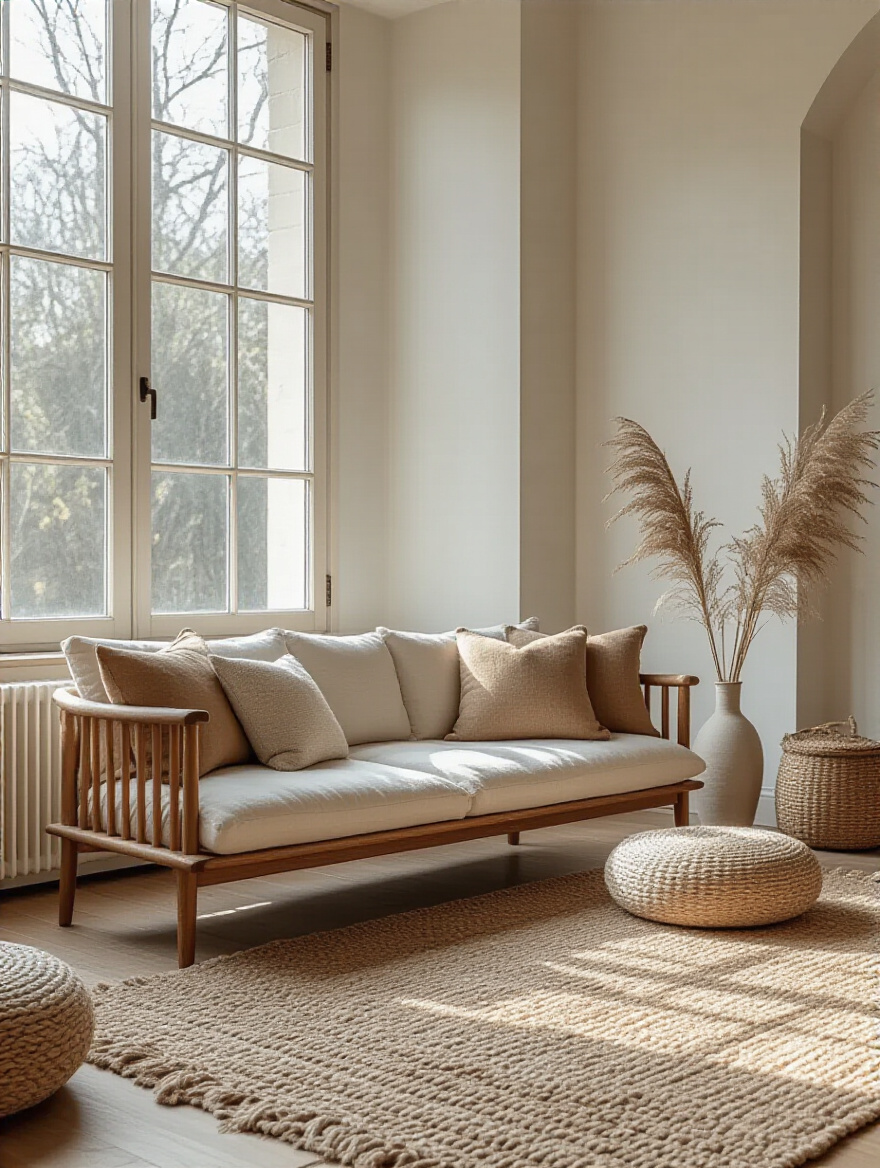
Investing in quality means buying something once. Look for solid wood construction, high-density foam cushions, and durable fabrics. A good sofa should feel heavy and solid. A good media console should have built-in ventilation and cable management. Yes, it costs more upfront, but it’s way cheaper than replacing garbage furniture every couple of years. Plus, quality pieces just feel better. Your guests will notice the difference when they sink into a supportive, comfortable couch versus perching on a flimsy frame.
It’s the ultimate “less but better” move. One great sofa is infinitely better than three mediocre ones. It supports the mission of comfort and longevity.
9. Opt for Clean Lines and Simple Silhouettes in Furniture Design
There’s a very practical, technical reason why minimalist design favors clean lines: they don’t get in the way. Fussy, ornamental furniture creates visual clutter that competes for your brain’s attention. When you’re trying to get lost in a movie, the last thing you want is to be distracted by the elaborate scrollwork on your coffee table’s legs. Simple, straight lines and smooth surfaces help your eyes relax and focus on the screen.
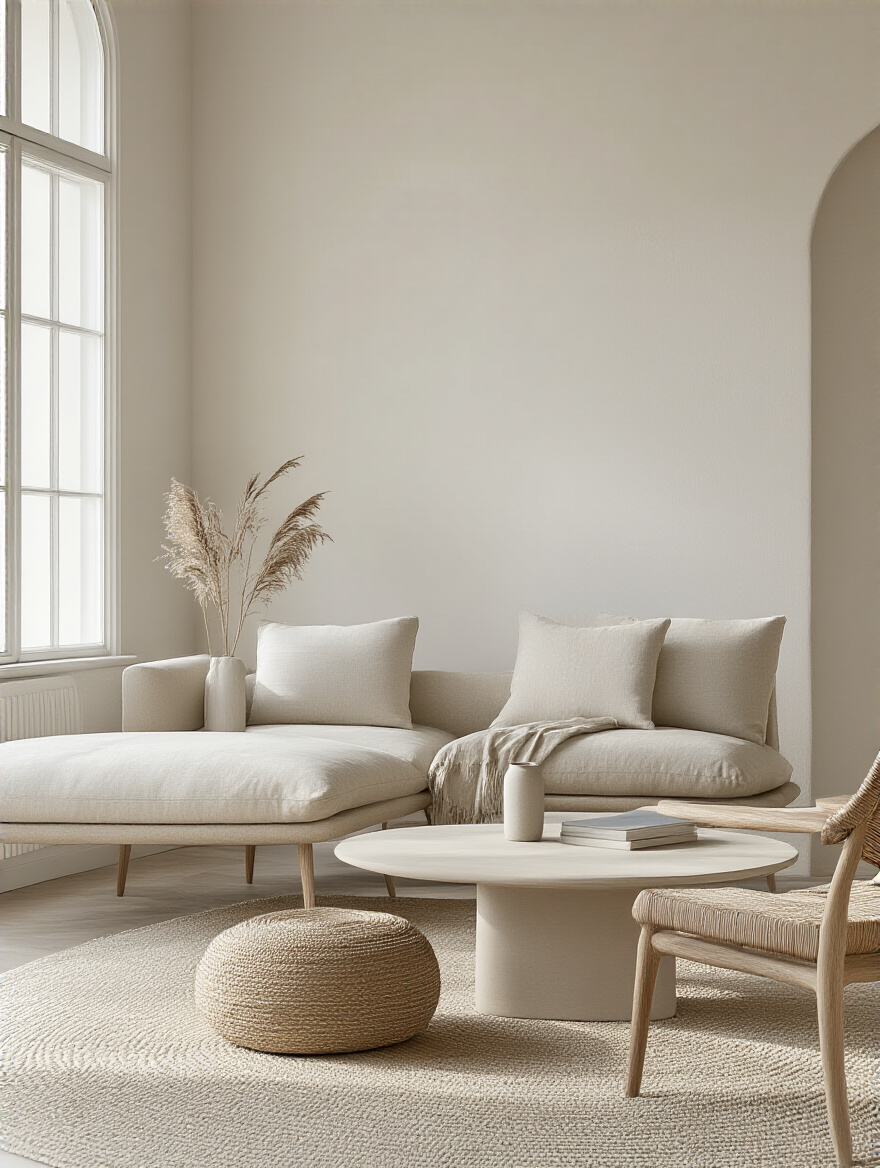
Clean lines are also critical for sightlines. I once visited a client’s home where they had this massive, chunky armchair that completely blocked the view of the TV from one end of the sofa. It was a comfortable chair, but it was in the wrong spot and had the wrong profile. We swapped it for a chair with a lower back and slim legs, and it completely opened up the room. Your furniture should support the experience, not obstruct it.
Think of your furniture as the supporting cast. The content on the screen is the star of the show. The supporting cast’s job is to make the star look good, not to steal the spotlight.
10. Leave Ample Empty Space to Enhance Feelings of Calmness
In the world of audio, empty space is your friend. It’s called “acoustic treatment,” and you can get it for free. A room jam-packed with furniture and clutter creates a ton of hard surfaces for sound waves to bounce off, making your audio sound messy, echoey, and chaotic. By strategically leaving empty space, especially between your speakers and your listening position, you allow the sound to travel cleanly to your ears. Your Dolby Atmos system will thank you.
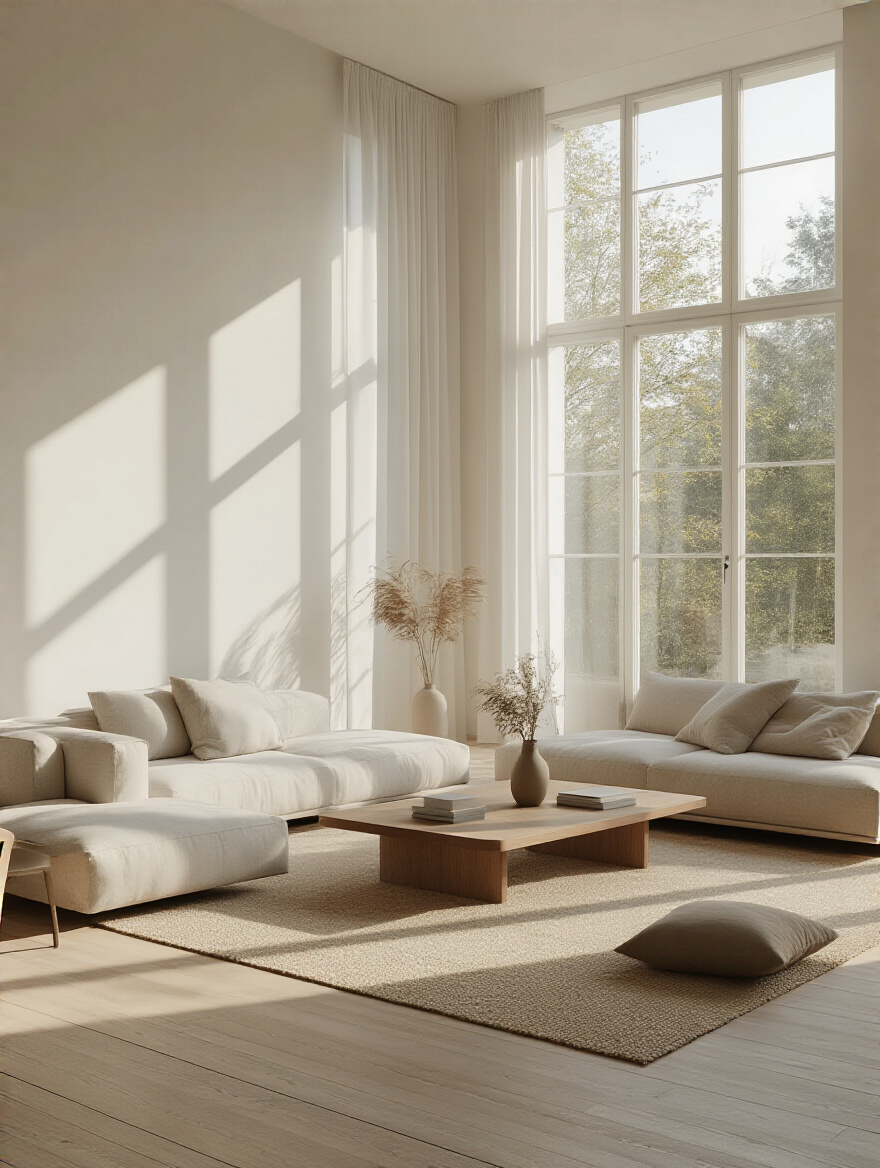
From a social perspective, empty space is breathing room. It’s room to move. At a party, people don’t just sit; they stand, they mingle, they move around. A minimalist layout with clear pathways makes a space feel more energetic and welcoming for a crowd. No one wants to be constantly squeezing past furniture to get a drink. Negative space gives you flow.
So don’t think of it as “empty” space. Think of it as functional space. It improves acoustics, it facilitates movement, and it gives your eyes a place to rest, all of which contribute to a more comfortable and enjoyable experience for you and your guests.
11. Implement Strategic Zone Planning for Defined Activities
A great entertainment room often has to be a jack-of-all-trades. You need a way to define different activities without putting up walls. This is zone planning. You use furniture, lighting, and rugs to create distinct areas with different missions. The main seating area, focused on the TV, is the “Cinema Zone.” It gets the best sofa and a large, soft rug to anchor it and improve sound absorption.
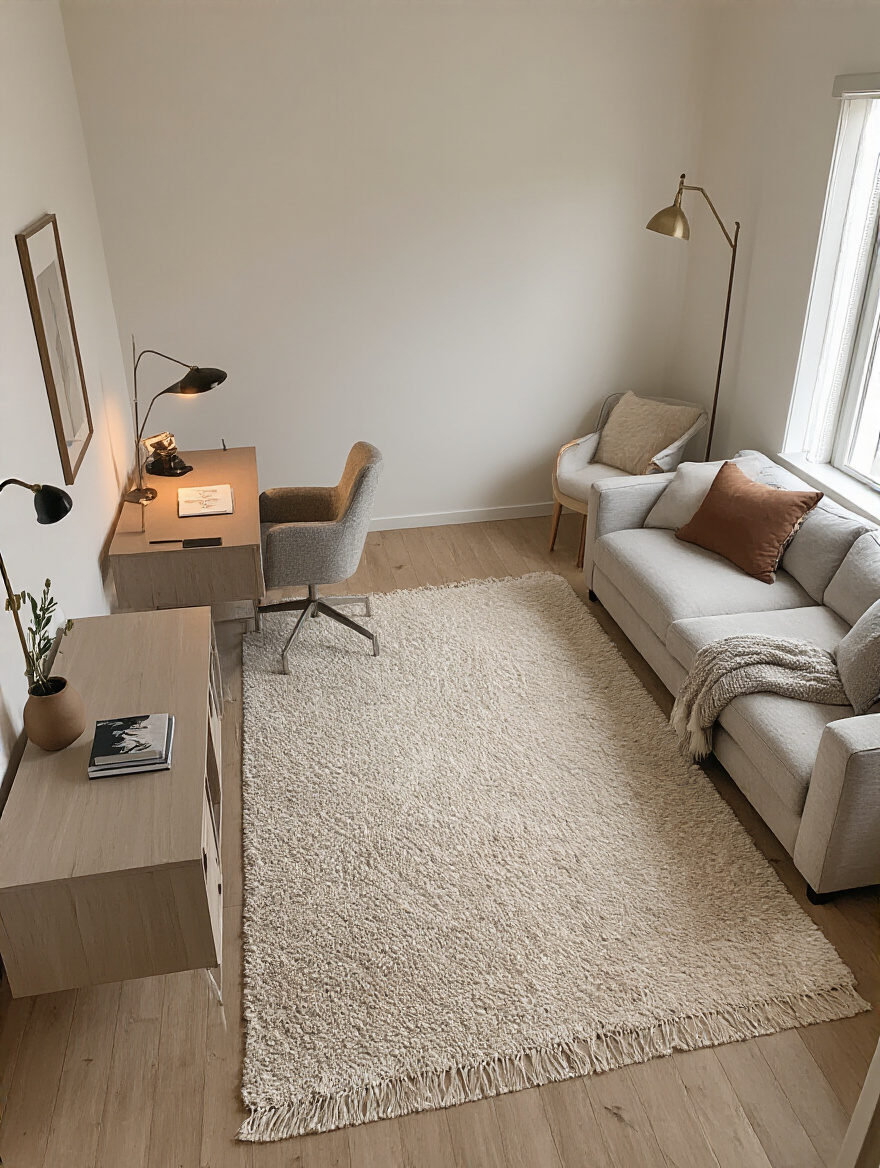
Over in a corner, you can create a “Gaming Nook” with a single comfortable chair, a task light, and a small table for a headset and controller. Near the back of the room, you might have a “Bar Zone” with a slim console table for drinks and snacks. You’re creating mini-environments, each optimized for a specific task. You can use smart lighting to enhance this—bright, cool light in the gaming zone, warm, dim light in the cinema zone.
This approach makes your single living room feel like a multi-room venue. It’s incredibly efficient and allows you to host different activities simultaneously without everything feeling jumbled together.
12. Consider Scaled Furniture Sizes for Room Proportion
I’ve seen so many people make this mistake. They fall in love with a gigantic, cloud-like sectional in a massive showroom, stuff it into their normal-sized living room, and are then shocked when it feels like the room is 90% couch. It’s a classic blunder. The scale of your furniture has to match the scale of your room.

Here’s the shortcut: use painter’s tape. Before you buy anything, measure the dimensions of the sofa or media console you’re considering and tape out its exact footprint on your floor. Live with it for a day. Can you walk around it comfortably? Does it block a doorway? Does it leave enough room for a side table? This simple trick gives you a real-world feel for the furniture’s mass and prevents you from making a very expensive, very large mistake.
Properly scaled furniture creates balance and flow. It ensures people can move freely and that the room feels spacious and intentional, not like a crowded storage unit.
13. Prioritize Comfortable Seating Over Excessive Options
If I can only give you one piece of advice for an entertainment room, it’s this: your sofa is the most important piece of gear you will buy. More important than the TV, more important than the speakers. Why? Because if you’re not comfortable, you’re not going to enjoy any of it. Your guests will be fidgeting an hour into the movie, and you’ll be constantly shifting during that gaming session.
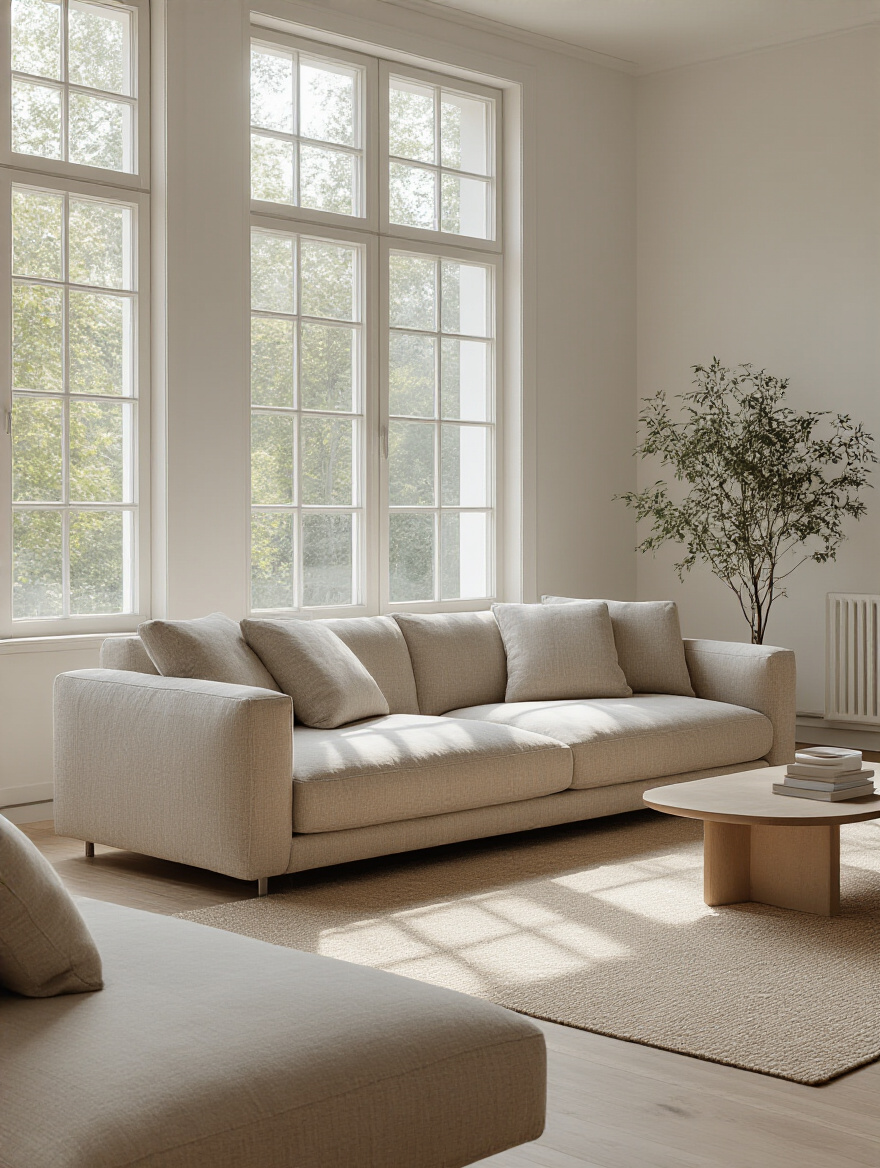
Forget about filling the room with a bunch of stylish but miserable accent chairs that no one ever sits in. Instead, invest that money and space in one, absolutely incredible, sink-into-it-and-never-leave-it sofa or sectional. Go to the store and actually sit on it. Lie down on it. Spend at least 15 minutes with it. Is the seat deep enough? Is the back supportive? A great sofa is the foundation of every great social gathering.
This is the heart of your hospitality. Making your guests truly comfortable is the best way to ensure they have a great time and want to come back.
Cultivating Calm Through Color & Light Strategies
Now for the magic. Color and light are the most powerful tools for setting a mood. In a minimalist entertainment space, we use them to eliminate distractions, enhance the on-screen action, and create an immersive atmosphere that can go from bright and social to dark and cinematic at the touch of a button.
14. Select a Neutral Base Color Palette for Serene Walls
A neutral color palette isn’t about being boring; it’s a technical choice for peak video performance. White, light grey, or beige walls act like a blank canvas. They don’t “tint” the light in the room, which means the colors projected from your TV or projector are pure and accurate. A red wall will bounce red light onto your screen, throwing off the color balance. A neutral wall ensures the filmmaker’s vision is what you see.
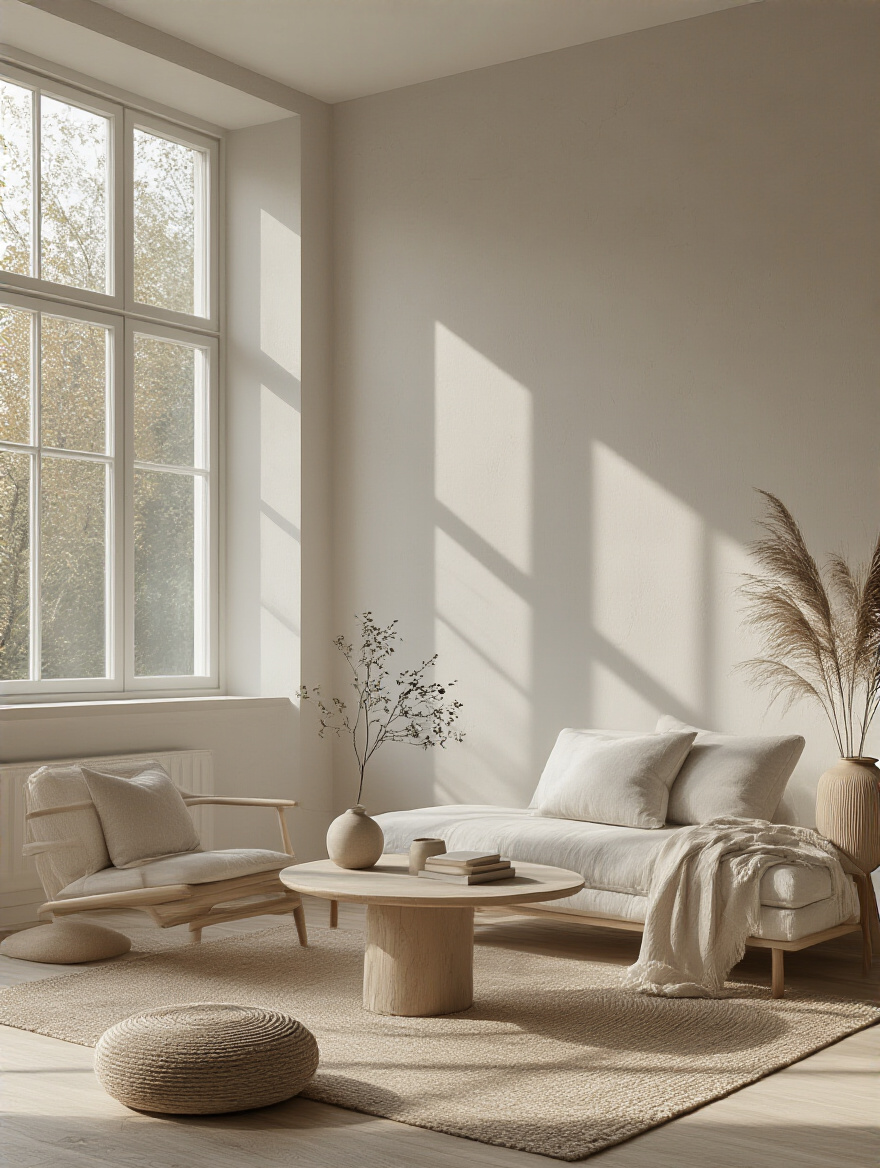
Furthermore, dark walls suck up light, which can make your TV or projector image look dim and washed out. Lighter, neutral walls reflect ambient light around the room, making the image appear brighter and more vibrant without you having to crank up the brightness settings. For the ultimate setup, a medium-to-dark grey is often the professional’s choice for a dedicated theater wall, as it boosts perceived contrast, making blacks look deeper.
So think of your wall color as a piece of calibration equipment. A neutral palette is the first step in creating a reference-quality viewing environment.
15. Introduce One or Two Calming Accent Colors Thoughtfully
This is where you can have some fun, but we’re going to do it with technology. Your accent color doesn’t have to be a pillow. It can be light. With smart LED strips like Philips Hue or Govee, you can add a wash of color behind your TV, under your media console, or along a shelf. This is called bias lighting, and not only does it look cool, but it also reduces eye strain when watching in a dark room.
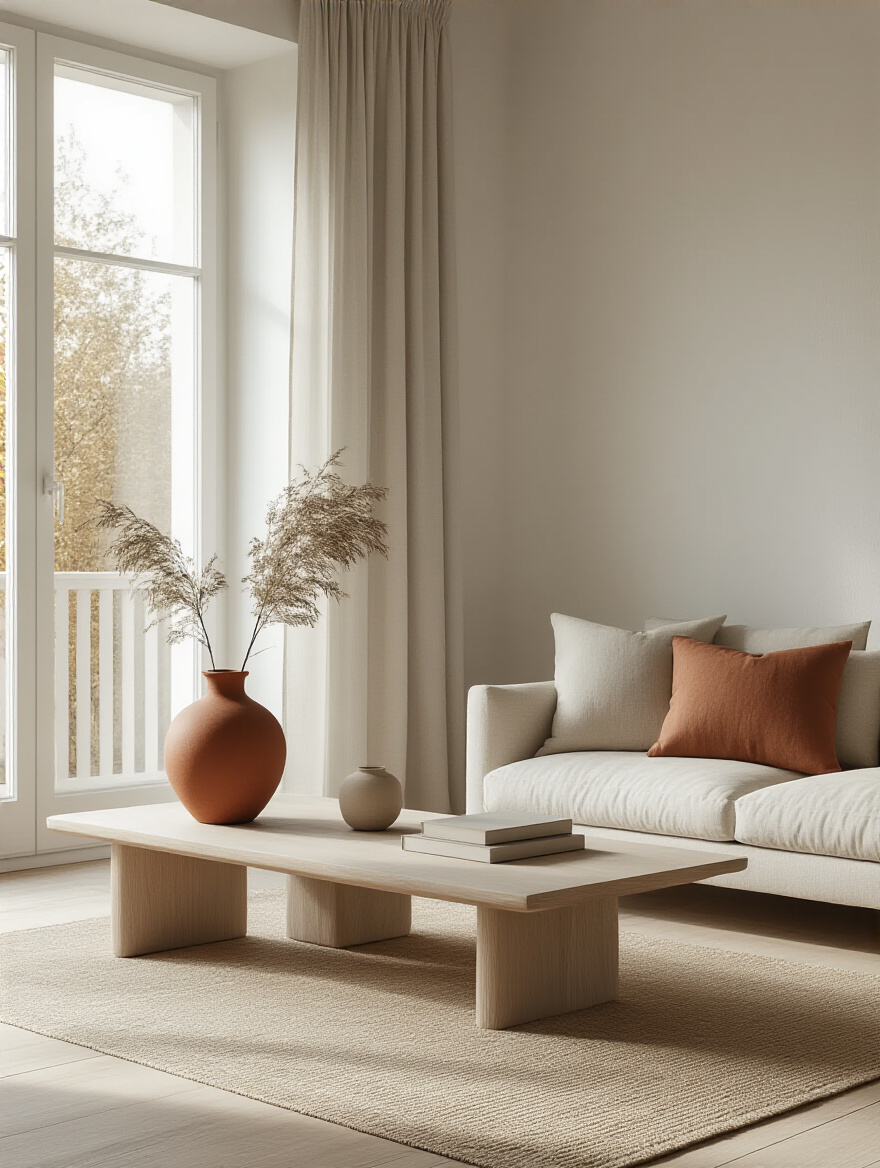
You can create scenes for different activities. A cool blue or energetic purple for gaming. A warm, soft orange for a cozy movie night. A vibrant, slowly-shifting rainbow for a party. The accent color becomes dynamic, an active part of the experience, rather than a static design choice. You can also tie in small physical objects—a piece of art or a vase that picks up on one of your go-to lighting colors to create a cohesive look.
This is the modern way to use color. It’s interactive, functional, and way more impressive than a painted accent wall.
16. Maximize Natural Light with Sheer Curtains or Bare Windows
Natural light is great for day-to-day living and daytime gatherings. It makes a space feel open and alive. Sheer curtains are a fantastic choice because they diffuse light beautifully, cutting down on harsh glare that can be a nightmare to see a screen in, while still keeping the room bright. So for the 90% of the time you’re not in full cinema mode, this is the way to go.

But—and this is a big but for any serious entertainment enthusiast—you absolutely need a way to kill that light on demand. My pro-tip here is a dual-track curtain system. On the inner track, closest to the window, you have your beautiful, light-filtering sheers. On the outer track, you have heavy, sound-absorbing, 100% blackout curtains. With one pull, you can transform the room from a bright, airy living space into a pitch-black cinema. Better yet, motorize them for the ultimate “wow” factor.
This two-in-one solution gives you the best of both worlds: a beautiful, naturally lit room by day and a perfectly dark, distraction-free theater by night.
17. Integrate Varied Lighting Sources for Ambient Mood Creation
A single overhead light is a crime against good design and atmosphere. To create a truly versatile and comfortable space, you need to layer your lighting. This means having at least three types of light sources that you can control independently. First is Ambient Light: This is your general, room-filling light, usually from dimmable recessed cans or a central fixture. Its job is to make the room usable.
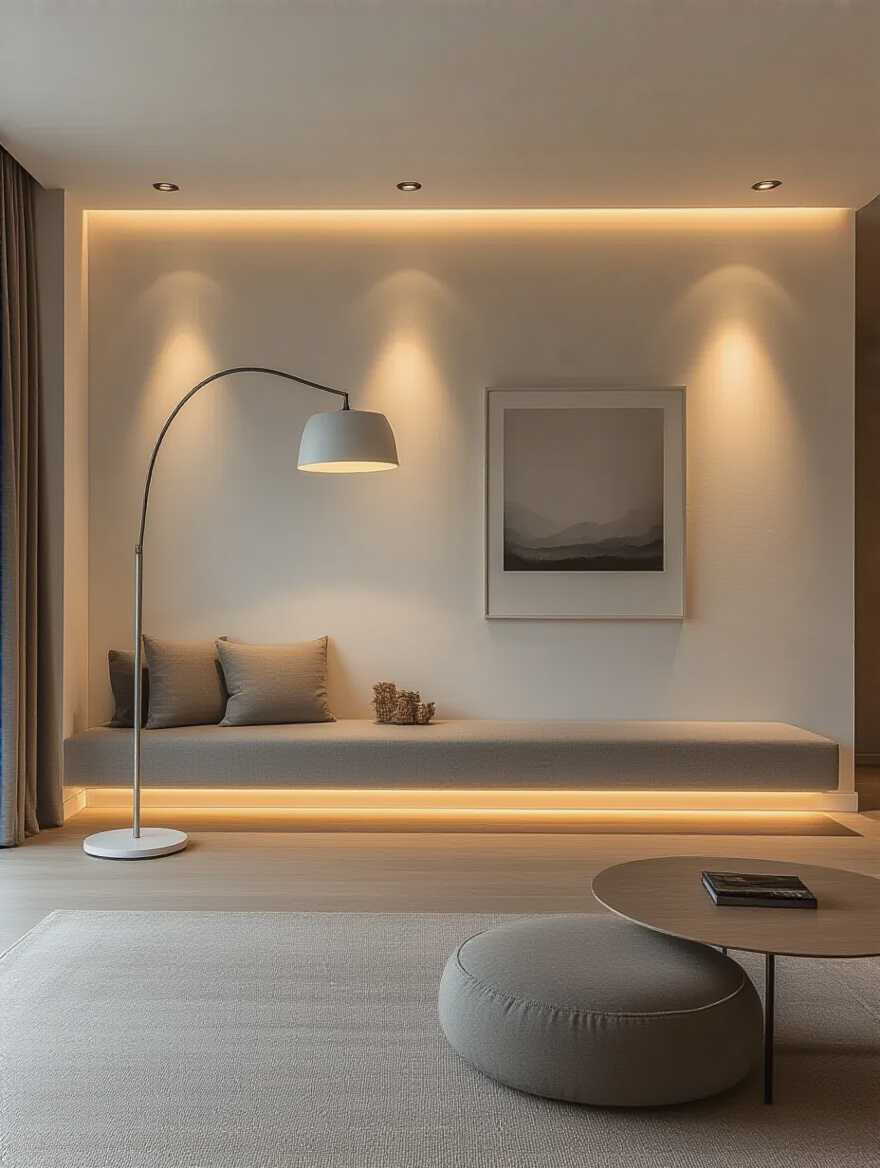
Second is Task Light: This is focused light for a specific purpose, like a floor lamp next to a chair for reading, or a small lamp on a side table so you can see your remote. Third is Accent Light: This is the fun stuff. It’s the bias lighting behind the TV, the light inside a cabinet highlighting your gear, or a spotlight on a piece of art. It creates depth and drama. Every single one of these lights should be on a dimmer. No exceptions.
The shortcut to making this all work effortlessly is a smart lighting system. With a press of a button on your phone or a voice command, you can switch between scenes like “Movie Night” (all lights off except for low bias lighting), “Party Mode” (ambient lights at 50%, accent lights on), and “Cleaning” (all lights at 100%). It’s the ultimate tool for controlling the vibe of your room.
18. Avoid Overly Busy Patterns; Prioritize Subtle Textures
Busy, high-contrast patterns are a massive distraction. Whether on a rug or a pillow, they create visual noise that your brain has to process, pulling your attention away from the screen. In a minimalist room, we trade patterns for textures. Think of a thick, chunky knit blanket, a nubby linen pillow, a smooth leather chair, a soft wool rug, or even acoustic panels with a nice fabric finish.
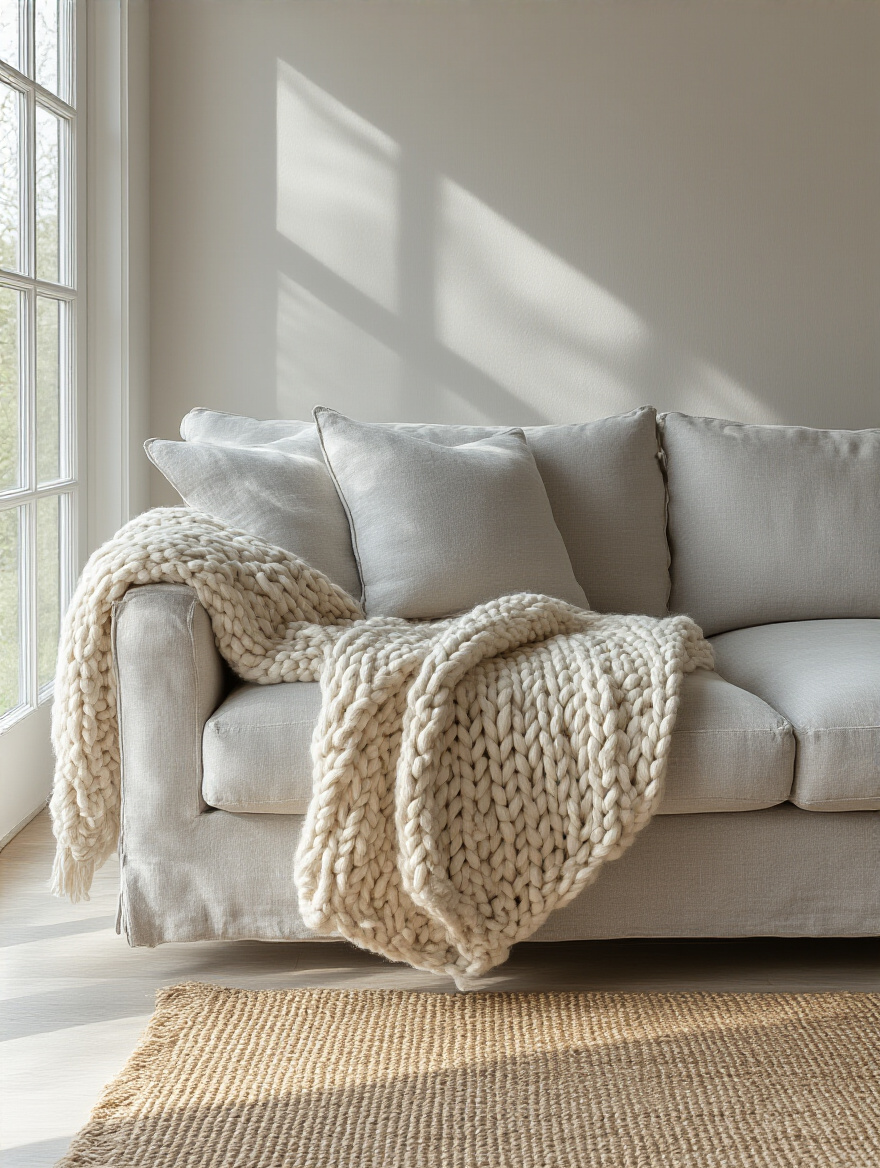
Texture adds warmth and visual interest without being loud about it. And here’s the tech-savvy bonus: soft textures are fantastic for acoustics. A thick rug, heavy curtains, and soft furnishings all absorb sound, preventing that annoying echo and reverb you get in a sparse room with hard floors. They “tune” the room, making dialogue clearer and sound effects more impactful.
So when you’re choosing soft goods, think about how they feel and how they’ll help the room sound, not just how they look. Texture is a functional tool for creating a room that’s both cozy and sonically balanced.
Intentional Decor & Thoughtful Personal Touches
We’ve built a high-performance, comfortable, and clean foundation. The final layer is about making the space yours. This isn’t about adding clutter. It’s about a few, carefully chosen items that tell a story, spark a conversation, and complete the vibe.
19. Curate Art That Resonates, Limiting Quantity for Impact
Instead of a cluttered gallery wall with a dozen small frames, go for impact. One single, large-scale piece of art is far more powerful. And for an entertainment space, let’s make that art functional. Think about a badass, oversized, vintage-style movie poster for one of your favorite films. Or a large, abstract canvas that contains colors you can match with your smart lighting for a cohesive, designed look.
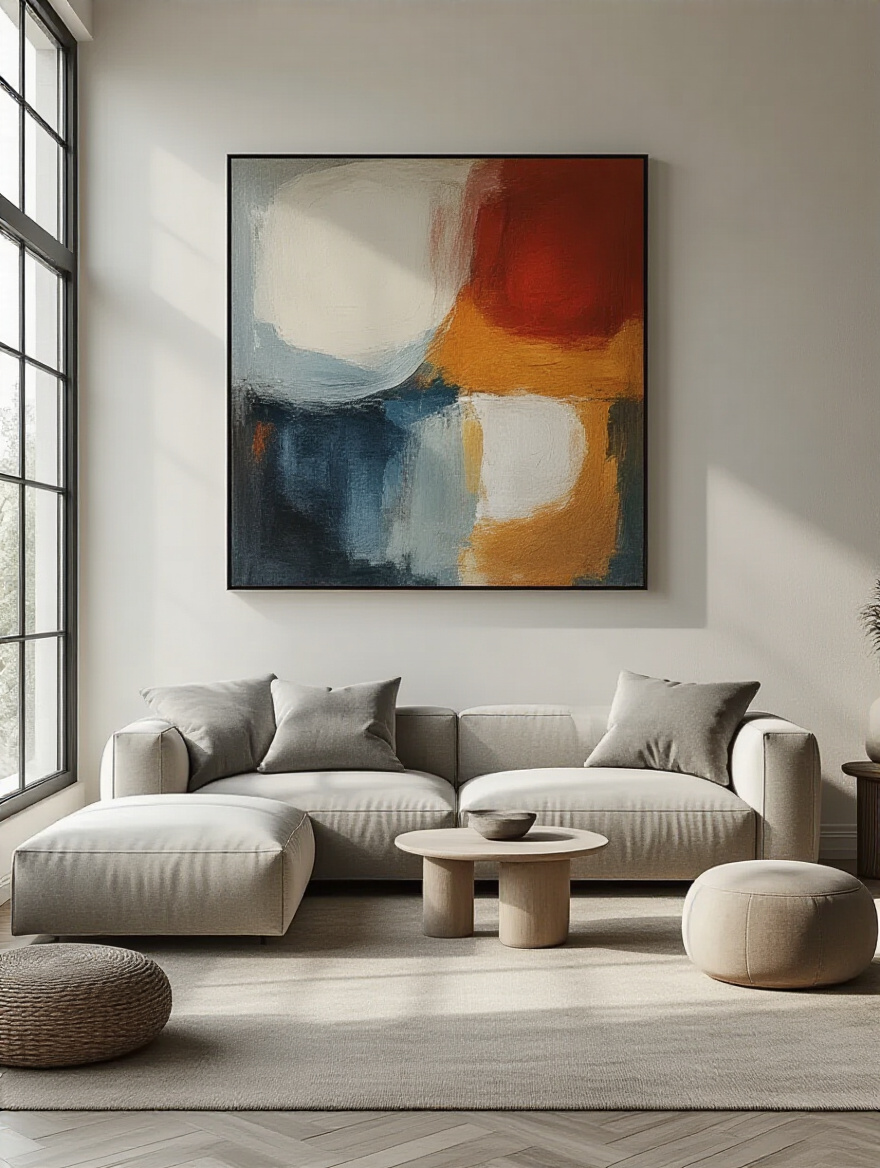
My favorite trick is to use art to conceal technology. There are companies that make custom-printed acoustic panels, so your art is literally improving your room’s sound. You can also get motorized art that rolls up to reveal a wall-mounted TV. It’s the ultimate “now you see it, now you don’t” centerpiece. The key is to make your art a statement, a conversation starter that feels integrated into the purpose of the room.
Fewer pieces with greater impact means each one feels more special. It turns your wall from a random collection into a curated gallery.
20. Add Minimal Live Plants to Introduce Natural Vitality
Plants are great. They add life, a pop of organic color, and can even help clean the air. But in a minimalist entertainment room, we can make them work even harder. A large, structural plant like a Fiddle Leaf Fig or a Bird of Paradise, placed in a simple, modern planter, can be a fantastic way to camouflage gear.
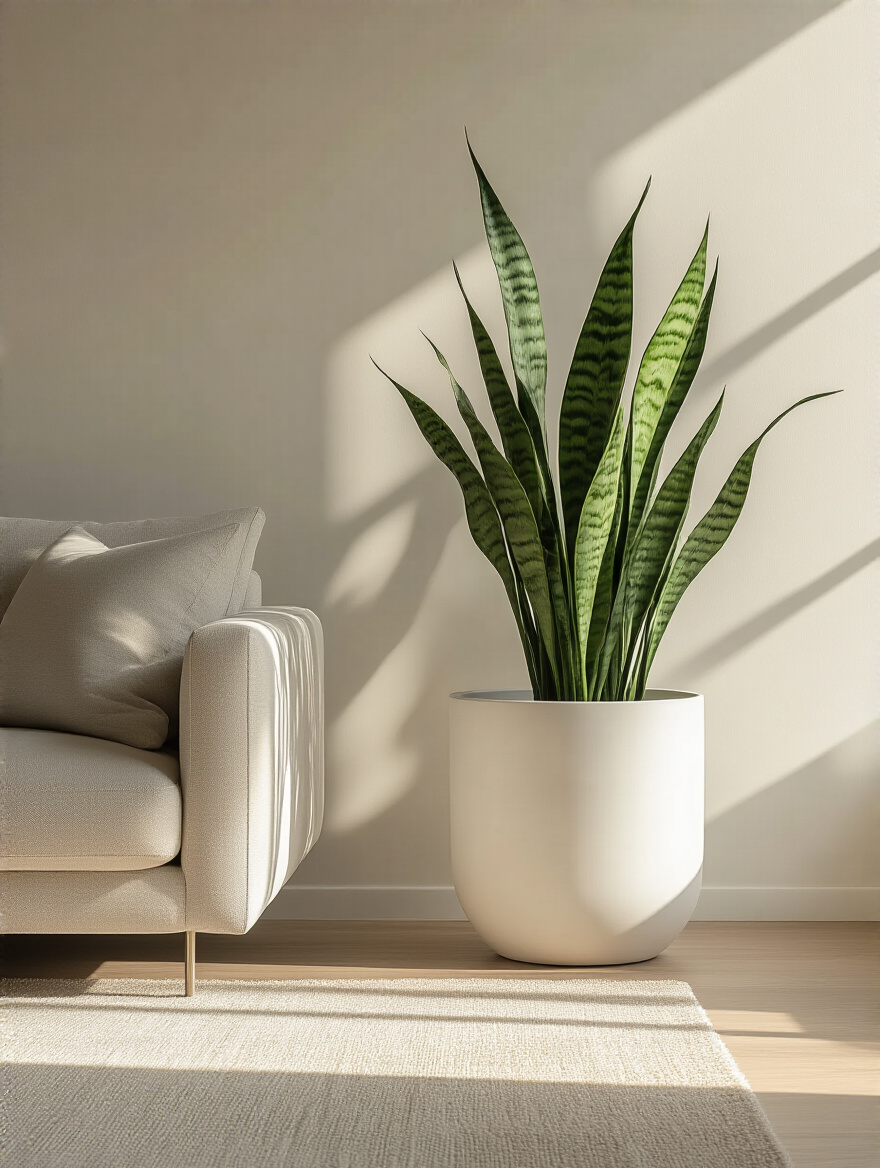
Got a big, black, boxy subwoofer that looks ugly in the corner? Tuck it right behind a tall, leafy plant. Suddenly, the subwoofer disappears and you have a beautiful, intentional design element. Plants can also help with acoustics by breaking up sound waves. Just don’t go overboard and turn your room into a jungle. One or two carefully chosen, architectural plants are all you need to add that touch of life and solve a design problem at the same time.
It’s about making every element, even the living ones, serve the room’s dual purpose of looking great and performing flawlessly.
21. Select Essential Throw Pillows and Blankets for Texture
Comfort is mission-critical. Blankets and pillows aren’t just decorative fluff; they are functional tools for coziness. During a long movie or gaming session, people want to get comfortable, and having a good blanket to curl up with or a supportive pillow for your back makes all the difference. Keep the selection minimal—maybe two pillows and one high-quality, incredibly soft throw blanket per sofa.
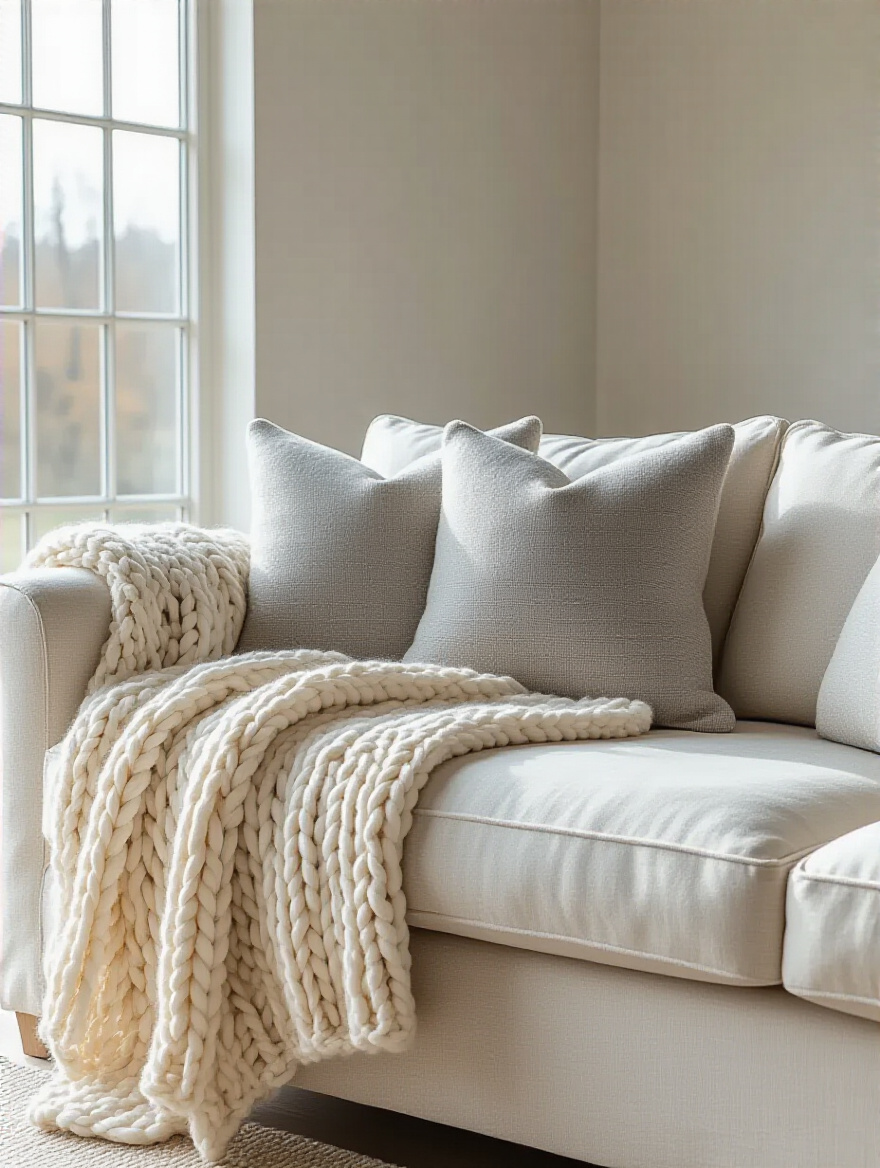
Like with the rug, these soft surfaces are also doing double duty as acoustic treatments. Every soft object you add to the room helps absorb sound and reduce echo, making your audio sound cleaner and more professional. So, when choosing them, prioritize high-quality, tactile materials. Think merino wool, soft linen, or even a high-quality faux fur.
These items are direct points of contact for you and your guests. Investing in quality here directly translates to a more luxurious and comfortable experience for everyone.
22. Conceal Cables and Wires for a Polished, Uncluttered Look
If there is one thing that will absolutely destroy the vibe of a beautiful, minimalist room, it’s a “rat’s nest” of wires hanging behind the TV. It’s my number one pet peeve. It looks sloppy, attracts dust, and screams “amateur hour.” Hiding your cables is the single most important finishing touch for any entertainment setup. It is non-negotiable.
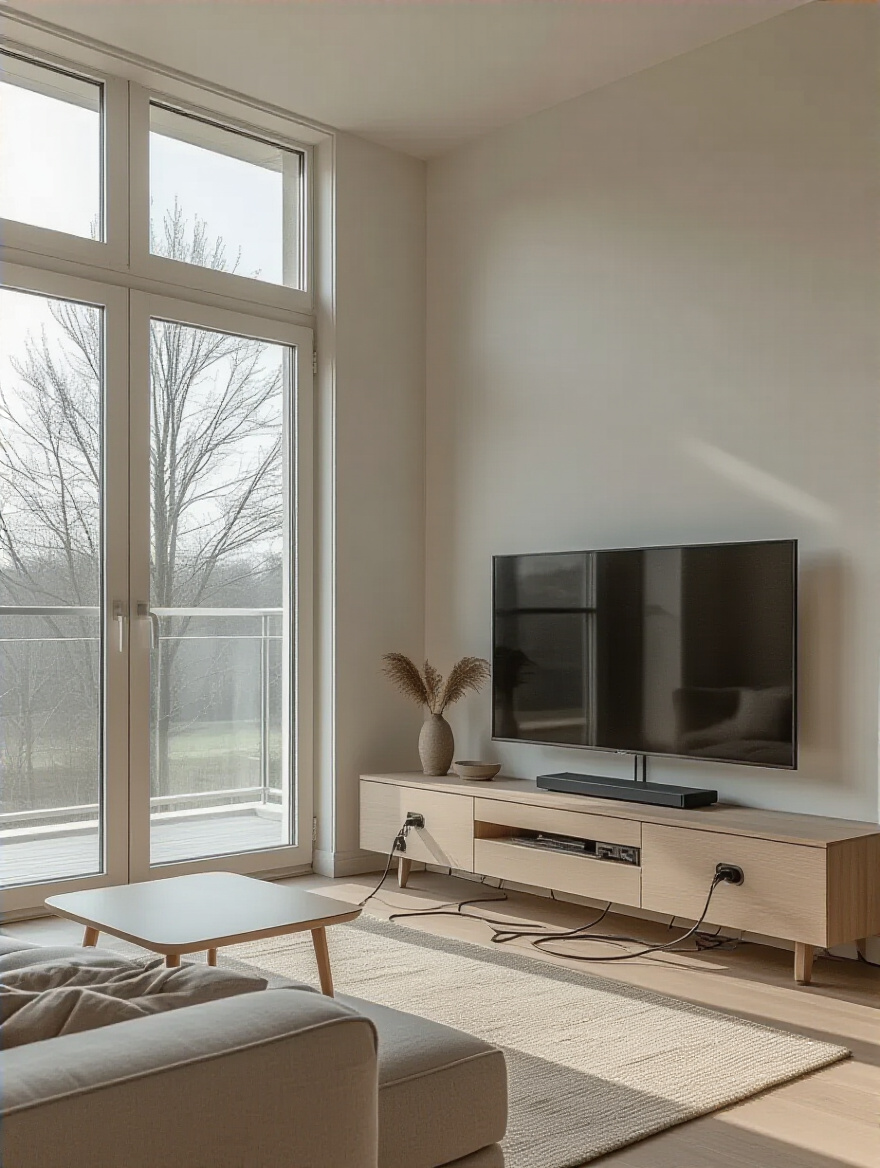
There are so many great solutions now. For a clean, professional look, an in-wall cable management kit (like the Datacomm kits) is the best option. It lets you run cables from the TV down to your console inside the wall. If you can’t cut into your walls, use a sleek cable raceway that sticks to the wall and can be painted to match. For bundling wires behind your media center, use braided cable sleeves and reusable Velcro ties. Never, ever use zip ties—they’re a nightmare if you ever need to change something. And for the love of all that is holy, label both ends of every cable. You’ll thank me later.
A clean cable setup is the mark of a true enthusiast. It shows attention to detail and a respect for both the technology and the design.
23. Personalize With One or Two Sentimental Items Mindfully
Your room needs to reflect you. But instead of a dozen little knick-knacks, choose one or two items that have a real story and make them a centerpiece. In an entertainment room, this is a perfect opportunity to showcase something that relates to your passion. Maybe you have a vintage turntable you want to display on a floating shelf. Or a collection of your favorite, most iconic video game controllers arranged on a stand.

I worked with a client who was a huge movie buff, and we built a set of thin, custom-lit floating shelves to display his replica prop collection—a lightsaber hilt, a flux capacitor, a Batarang. It was just a few items, but it instantly told you who he was and what he loved. It became an immediate conversation starter for anyone who visited. The items aren’t clutter; they are curated pieces of your personality.
This is what turns a well-designed room into your room. It’s the final touch that infuses the space with soul and makes it a genuine reflection of what you love.
Conclusion
So there you have it. Creating a minimalist living room isn’t about deprivation or living in a boring white box. It’s the exact opposite. It’s about designing a high-performance, incredibly comfortable, and deeply personal space that’s ruthlessly optimized for what matters most: connection, immersion, and creating unforgettable memories with the people you care about.
By focusing on your room’s mission, investing in quality over quantity, and using technology to enhance the atmosphere, you build a space that works harder for you. It’s a room that can transform from a bright, social hub to a dark, cinematic sanctuary at the touch of a button. It’s clean, not because it’s empty, but because every single thing in it has a purpose. Now go turn your living room into the best entertainment spot in town.
Meta Description: Build a minimalist living room that’s perfect for entertainment. Riley’s 23 expert tips combine smart tech, comfort, and style for the ultimate social space.
